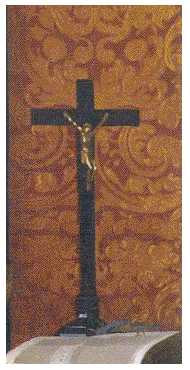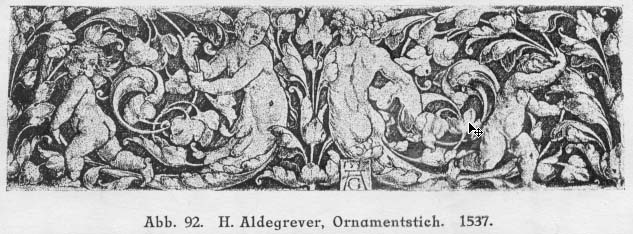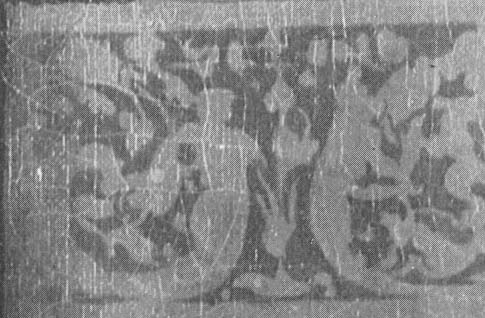Gold tooled-leather and crucifix
 'About
seven ells [feet] of gold tooled-leather on the wall'
'Omtrent seven ellen goutleer aende muyr' in the inner kitchen
("binnekeucken"). Room C. Gold tooled-leather
is made of rectangular pieces of leather which have been heavily
tooled into raised surfaces in a regular pattern; an extremely thin
layer of silver, which has been beaten into gossamer sheets of
silver, was then glued to this leather. Finally a varnish and
possibly some pigments are added. This results in a golden shine.
'About
seven ells [feet] of gold tooled-leather on the wall'
'Omtrent seven ellen goutleer aende muyr' in the inner kitchen
("binnekeucken"). Room C. Gold tooled-leather
is made of rectangular pieces of leather which have been heavily
tooled into raised surfaces in a regular pattern; an extremely thin
layer of silver, which has been beaten into gossamer sheets of
silver, was then glued to this leather. Finally a varnish and
possibly some pigments are added. This results in a golden shine.
'An ebony wood crucifix' 'Een ebbenhout cruys' In the great
Hall ("groote zael") Room I. The crucifix was an item found almost
exclusively in Roman Catholic households and in hidden churches.
Within the culture of the Dutch Reformation (the state supported
church), showing and revering a crucifix was uncommon. See
interfaith marriage.
On Februari 3, 2003 mr. Harry Vlamings from Tilburg, The
Netherlands emailed the following message: "The panel of gold tooled
leather on both The Letter and Allegory of Faith show a
merman design ; this is derived from a design sample book by the
German graphical designer Heinrich Aldegrever. I stumbled upon this -
and the similarity is striking." (images see below).
Swillens in his 1950 book pointed at the coats of arms of the
former burgomaster Theodorus Meerman - Merman as opposed to mermaid -
who helped refurbish the St Luke building (p. 35). See this building
in the yellow section Delft Artist &
Patrons.
Illustration above: a detail from the
painting "Allegory of Faith" in the Metropolitan Museum of Art, New
York City.
Illustrations below Aldegrever print
illustrated in: Hermann Schmitz, Soest, Seeman, Leipzig 1908,
page 102. Below the Vermeer detail.


Note : This object was part of the
Vermeer-inventory as listed by the clerk working for Delft notary
public J. van Veen. He made this list on February 29, 1676, in the
Thins/Vermeer home located on Oude Langendijk on the corner of
Molenpoort. The painter Johannes Vermeer had died there at the end of
December 1675. His widow Catherina and their eleven children still
lived there with her mother Maria Thins.
The transcription of the 1676 inventory, now
in the Delft archives, is based upon its first full publication by
A.J.J.M. van Peer, "Drie collecties...", Oud Holland, 1957,
pp. 98-103. My additions and explanations are added within square
brackets [__]. Dutch terms have been checked against the
world's largest language dictionary, the Dictionary of the Dutch
Language (Woordenboek der Nederlandsche Taal , or WNT),
which was begun by De Vries en Te Winkel in 1882. In 2001 many
textile terms have been kindly explained by art historian Marieke te
Winkel.
Lit: Paul Begheyn, 'Johannes Vermeer en de Jezuïeten' in
Streven 63, 1996, p. 220-227.
This page forms part of a large encyclopedic site on Vermeer and Delft. Research by Drs. Kees Kaldenbach (email). A
full presentation is on view at johannesvermeer.info.
Launched December, 2002; Last update March 2, 2017.
Back to the Welcome page: click Welcome.
 'About
seven ells [feet] of gold tooled-leather on the wall'
'Omtrent seven ellen goutleer aende muyr' in the inner kitchen
("binnekeucken"). Room C. Gold tooled-leather
is made of rectangular pieces of leather which have been heavily
tooled into raised surfaces in a regular pattern; an extremely thin
layer of silver, which has been beaten into gossamer sheets of
silver, was then glued to this leather. Finally a varnish and
possibly some pigments are added. This results in a golden shine.
'About
seven ells [feet] of gold tooled-leather on the wall'
'Omtrent seven ellen goutleer aende muyr' in the inner kitchen
("binnekeucken"). Room C. Gold tooled-leather
is made of rectangular pieces of leather which have been heavily
tooled into raised surfaces in a regular pattern; an extremely thin
layer of silver, which has been beaten into gossamer sheets of
silver, was then glued to this leather. Finally a varnish and
possibly some pigments are added. This results in a golden shine.
